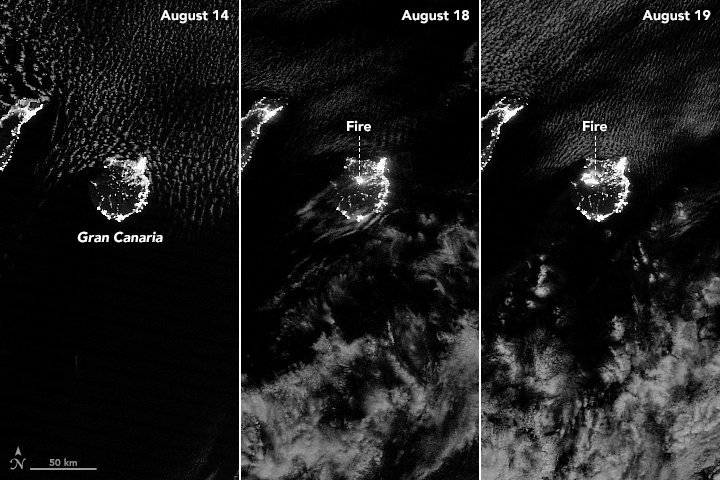‘Unprecedented Environmental Tragedy’ as Gran Canaria Island Engulfed by Wildfires

Fires on Gran Canaria, the second most popular island of Spain’s Canary Islands, have already forced the evacuation of thousands and remain uncontrolled.
A wildfire that ripped through the island of Gran Canaria in Spain’s Canary Islands on Saturday is reportedly advancing on two fronts in the mountainous regions of the island.
Spanish authorities held a press conference on Monday telling media outlets that the wildfire is “an unprecedented environmental tragedy” and that efforts are underway to contain it, but high temperatures, strong winds and low humidity are making containment difficult.
The authorities said that about 14 planes and helicopters, in addition to 1000 firefighters on the ground including 200 from the military, have been deployed to fight the expanding wildfire.
This deployment “is the biggest ever carried out in the Canaries and one of the biggest implemented in Spain in the past few years,” said Agriculture Minister Luis Planas.
They added that the blaze has spread into the island’s Tamadaba natural park, which is home to some of the Island’s oldest pine forests.
Lourdes Hernandez, an expert on wildfires at the World Wildlife Federation, called the Tamadaba natural park “the main green lungs of the island” in an interview with AFP.
“Tamadaba is lost, we can’t enter,” firefighter chief Carlos Velazquez also told reporters.
“When (weather) conditions begin to change that is when we can begin to control the fire,” he added.
The current fire is the third in ten days in the mountainous central region of the island, an area popular with hikers and home to several villages. The fires have forced the evacuation of the villages which are home to an estimated 9,000 residents.
NASA Imaging
On Tuesday, the National Aeronautics and Space Administration’s Earth Observatory released infrared imaging of the fires on Gran Canaria as the fires spread between August 14-19. NASA said its satellites first began tracking the fires on August 10th.

NASA Earth Observatory images by Joshua Stevens, using data from the Level 1 and Atmospheres Active Distribution System (LAADS) and Land Atmosphere Near real-time Capability for EOS (LANCE), and VIIRS day-night band data from the Suomi National Polar-orbiting Partnership.
According to NASA’s reporting, the fires are burning Canary pine which are some of the most fire-tolerant pine species in the world.
“The trees have several adaptations that allow them to survive and thrive after fires: thick bark that prevents heat damage, trunks that easily sprout new branches; and serotinous cones that depend on high heat to release seeds,” wrote NASA.
Additionally, while the number of fires in the Canary Islands has decreased the number of hectares burned per year has increased, reported NASA.
“On net, fires burn roughly the same average area each year, but they do it in a much more dramatic fashion because they are larger and more intense,” NASA wrote.
NASA also attributed the change in the nature of fires on the Canary Islands to climate change and man-made firefighting efforts.
“While increasing temperatures may have contributed to this trend, University of La Laguna scientist José Ramón Arévalo attributes much of the change to more active and effective firefighting efforts that now suppress most fires and lead to a build-up of flammable material in forests. Increased development and tourism also contribute by requiring that firefighters aggressively suppress fires over a wider area,” said NASA’s report.
Canary Island Fires Uncontained
The regional president of the Canary Islands, Angel Victor Torres, told reporters on Sunday that the fire has not been contained, controlled or stabilized.
“It’s a huge forest fire, extremely serious, which happened in a heatwave,” and it is still not under control, Torres told reporters late Monday, as AFP reported.
Officials said the fires have not affected the tourist regions on the island which are on the outskirts of the island in coastal beach communities.
The tourism industry on Gran Canaria remained unaffected “given that the fire is confined to upland areas”, with no resorts impacted and no flight delays, according to a statement by the Canary Islands government.
Scenes From the Fire
Scenes from the Gran Canaria fire were posted across Twitter.
Fighting major fires on Gran Canaria, Canary Islands yesterday, August 19th. Report via Jurnal de Vreme. pic.twitter.com/petsSODYTU
— severe-weather.EU (@severeweatherEU) August 20, 2019
Firefighters racing to save tied dogs in the major fires on Gran Canaria, Canary Islands yesterday, August 19th. Report: Islas Canarias pic.twitter.com/3ADc5L2hRW
— severe-weather.EU (@severeweatherEU) August 20, 2019
The #Gamescom is around the corner, but right now my mind and heart are in Gran Canaria (my home) which is suffering a massive, out-of-control blaze. Things don’t look good at all with this temperature, winds and low humidity. Over 8.000 evacuated and 3.400 hectares raised ? pic.twitter.com/3Wpt5Pshmf
— Battlefield Bulletin #IFGranCanaria ???? (@BFBulletin) August 19, 2019
Qué pena y qué rabia ver arder el corazón de Gran Canaria. Quiero enviar de nuevo toda mi solidaridad a los vecinos afectados y mi agradecimiento a los profesionales que luchan contra el fuego. Ojalá puedan controlarlo cuanto antes. #FuerzaGranCanariapic.twitter.com/ks1pz6fURN
— Albert Rivera (@Albert_Rivera) August 19, 2019








It may be without precedent there, but it certainly is not unprecedented in our not-so-brave new world. Australia, California, Portugal, Greece, Canada — the list and the severity are increasing exponentially:
https://en.wikipedia.org/wiki/List_of_wildfires